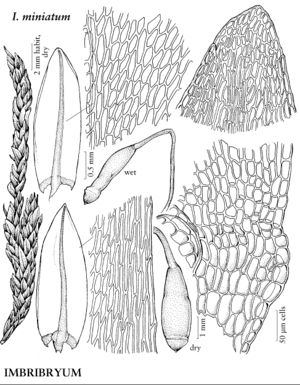Imbribryum
Bryologist 108: 449. 2005.
| Taxon | Illustrator ⠉ | |
|---|---|---|
 | Imbribryum miniatum | Patricia M. Eckel |
Plants small to medium-sized, in open to dense turfs, green, yellow-green, red-green, or red. Stems 0.5–3 (–5) cm, evenly foliate, julaceous or not, often branching; rhizoids few, micronemata present at base of stem, occasionally in clusters along stem, macronemata axillary. Leaves strongly imbricate when dry, erect when moist, ovate to lanceolate or rarely lingulate or triangular, flat or concave, 1–3 mm; base rarely decurrent; margins plane to strongly revolute, entire to serrulate distally, 1-stratose, limbidium absent or occasionally present; apex obtuse to acuminate; costa percurrent to short-excurrent with awn present, guide cells usually in 1 layer; alar cells not differentiated; laminal areolation heterogeneous; proximal laminal cells abruptly quadrate or rectangular, shorter than more distal cells, 1–2 (–3):1; medial and distal cells vermicular to rhomboidal or hexagonal, usually 3–6 (–8):1, walls thin to incrassate, rarely porose. Specialized asexual reproduction by rhizoidal tubers or absent. Sexual condition dioicous; perigonia and perichaetia terminal; perigonial and perichaetial leaves not much differentiated, outer perichaetial leaves larger, inner leaves smaller than leaves of innovations. Seta usually single, ± straight or somewhat flexuose. Capsule inclined or nutant, pyriform to clavate, 2–6 mm; hypophysis slender, not inflated or rugose; operculum convex, apiculate; peristome double; exostome yellowish, teeth well developed, lanceolate; endostome not adherent to exostome, basal membrane high, segments well developed, with ovate perforations, cilia long, appendiculate or sometimes nodose. Spores shed singly, 10–18 (–20) µm, smooth to papillose, yellowish or yellowbrown.
Distribution
Nearly worldwide, except Antarctica, tropical, subtropical, temperate to boreal regions, rare in arctic-alpine climates
Discussion
Species ca. 40 (6 in the flora).
Species of Imbribryum are relatively large, with elongate, evenly foliate stems and strongly imbricate leaves. The plants commonly grow on soil or rock, often associated with waterfalls, seeps and springs, or splashed rock. The plants have stout setae 1–3 cm in length; the capsules have well-developed peristomes. The genus is especially well represented in the mountains of New Guinea, the Neotropics, southeast Asia, and Africa. Most species produce spheric rhizoidal tubers; the presence of leaf axil bulbils, reported from European material of I. gemmiparum, has not been confirmed for North American collections. Many species are difficult to identify as they are morphologically variable, especially I. alpinum and I. muehlenbeckii. There is one undescribed species in the western United States, discussed under I. alpinum.
Selected References
None.
Lower Taxa
Key
| 1 | Leaves strongly imbricate when dry; distal laminal cells sometimes vermicular, 6-8:1; stems not or somewhat julaceous | > 2 |
| 1 | Leaves strongly to somewhat loosely imbricate; distal laminal cells not vermicular, usually 3-6:1; stems sometimes julaceous | > 3 |
| 2 | Costae percurrent to short-excurrent, awns stout; limbidium absent; proximal laminal cells quadrate to short-rectangular; capsule necks short. | Imbribryum alpinum |
| 2 | Costae short- to moderately long-excurrent, awns slender; limbidium present; proximal laminal cells rectangular; capsule necks long. | Imbribryum microchaeton |
| 3 | Stems strongly julaceous; leaves purple-red to brown-red, rarely dull olive green, strongly concave; apices rounded-obtuse to broadly acute, cucullate; costae percurrent; distal laminal cell walls strongly incrassate, oblique to costa. | Imbribryum miniatum |
| 3 | Stems not or weakly julaceous (except I. muehlenbeckii); leaves red, green, or yellow, concave to flat; apices rounded, acute, or acuminate, not cucullate; costae not reaching apex to excurrent; distal laminal cell walls thin to firm, parallel to costa | > 4 |
| 4 | Leaves weakly concave or flat, ovate-lanceolate; apices acute to acuminate; costae short-excurrent, awns slender, sometimes denticulate. | Imbribryum mildeanum |
| 4 | Leaves distinctly concave, ovate; apices rounded to acute; costae not reaching apex or rarely percurrent, awns absent | > 5 |
| 5 | Leaves green, sometimes yellowish, soft, loosely set, somewhat distant proximally along stem; proximal laminal cells short-rectangular, occasionally with scattered quadrate cells. | Imbribryum gemmiparum |
| 5 | Leaves red or red-green, sometimes dark green, rigid, imbricate, crowded; proximal laminal cells quadrate, with scattered short-rectangular cells. | Imbribryum muehlenbeckii |
"narrower" is not a number."narrow" is not a number.